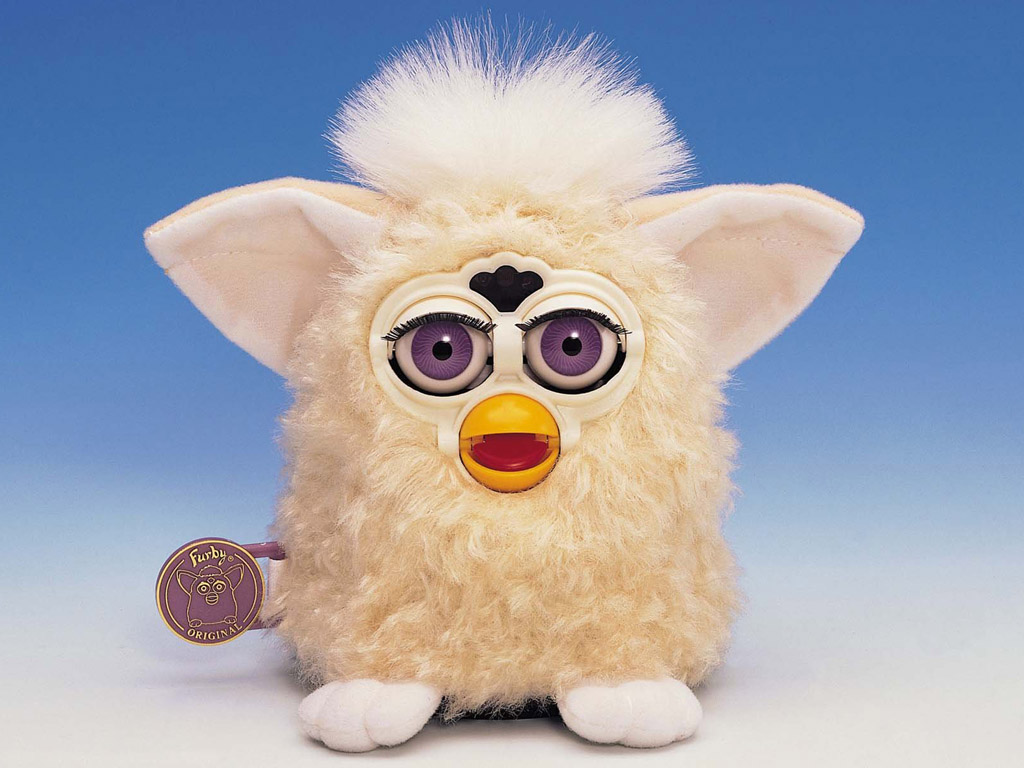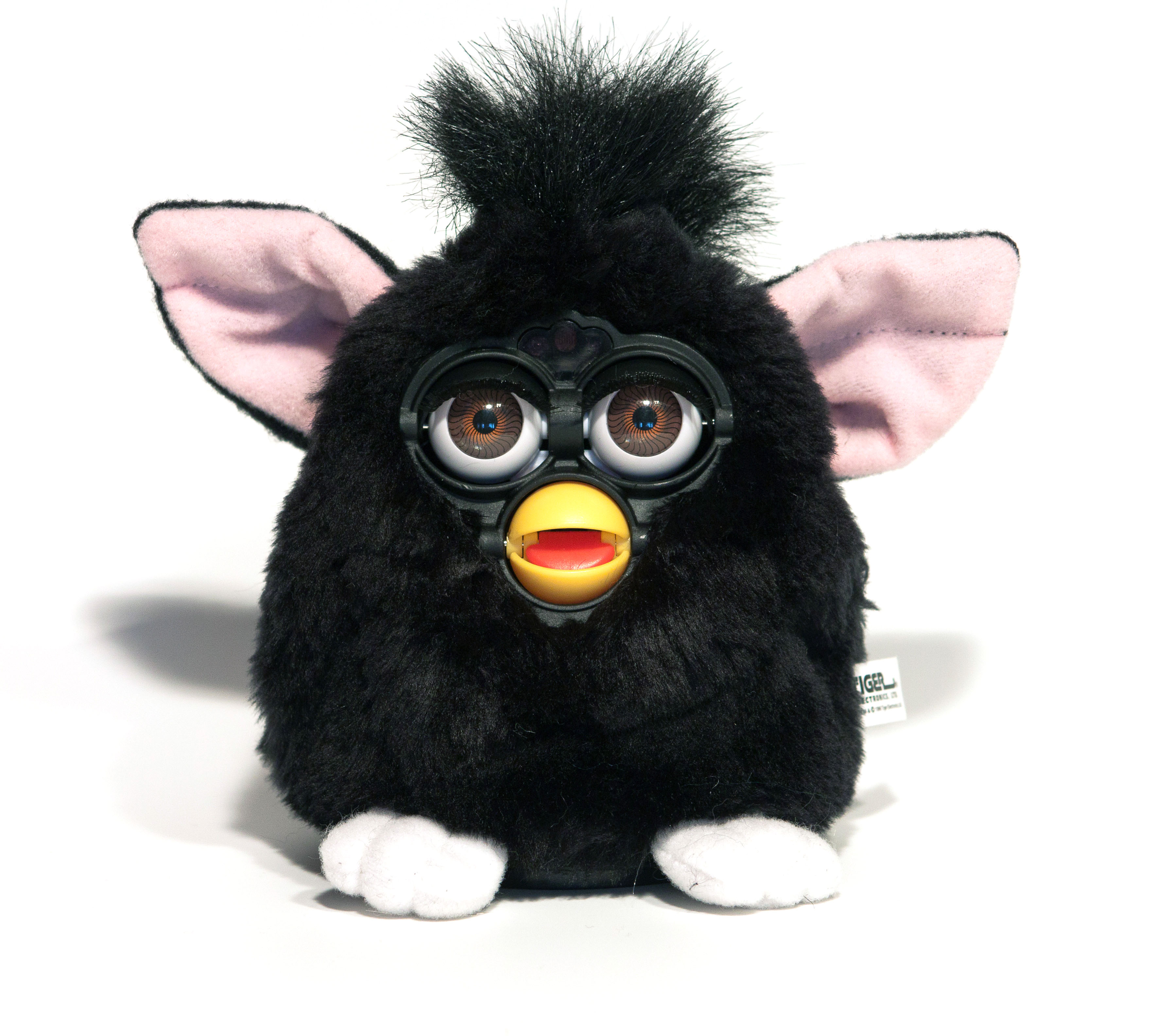
Nostalgia can make all of us into unreliable narrators of a romanticized past. Maybe Heinz baked beans pizzas weren’t actually that great, and perhaps the Furby that I stashed in my school locker, with the partial intention of pissing off teachers and fellow students, wasn’t as cute as rose-tinted memories would have me believe. However, the Furby was a relief to me: finally, a zeitgeisty totem I could really get behind as a tomboy who couldn’t stand Friends or the Spice Girls.
Furbies were first revealed at the 1998 American International Toy Fair by American toy manufacturer Tiger Electronics, after eighteen months in design and development led by Dave Hampton. Hampton was an inventor of toys and medical products, former Naval aviation electronics expert and Mattel product developer, who lived in a home without electricity in the Tahoe National Forest, according to a 1998 New York Times piece. In 1997, at the annual Toy Fair trade show, he encountered Tamagotchis for the first time and was struck by their obvious flaw: you can’t actually pet them.

Hampton set about planning his ideal robotic pet under the working name Furball. Hampton’s former Mattel colleague Caleb Chung created the mechanics, and toy and game inventor Richard C. Levy was later brought in to help get the Furby to market. To realize his goal of making a robotic creature that felt “alive”, the creatures squealed when detecting light changes, snored and sneezed. Hampton developed Furbish, a 200-word vocabulary formed from a mixture of languages he’d picked up (including Japanese, Thai, Chinese and Hebrew)—Furby’s “da,” for instance, is Mandarin for “big”; while “ay lo”,—Furby’s reference to “light”—is a variation of a Hebrew word for God.
“To realize his goal of making a robotic creature that felt “alive”, the creatures squealed when detecting light changes, snored and sneezed”
The release of the Furbies soon inspired the rabid competition between consumers that only Christmas-fad toys and gadgets can: fights broke out in stores; huge queues were commonplace. By early December 1998, toy makers in Asia were promising they’d have clones of the original in shops imminently to appease those who couldn’t get their hands on one. While the early 2000s saw Furbies fall out of favour, the 2012 reboot of Furbies from Hasbro—boasting sixteen new pattern and colour variations, and LED screens for eyes that shift into a number of baffling expressive contortions—proved hugely popular.
So far, so cute—until they get dark as hell. In the Gonzo tradition, I decided to buy myself a cheap second-hand Furby (this particular one was released in 2012) in the name of “research”. It was, indeed, adorable, and at first sat happily jabbering away—jabbering, chuckling, occasionally weedling around ninety degrees to chat with my friend. Okay, it was saying some odd things—sometimes it seemed to repeat “poo” and “bukake”, which seemed unusual—but this was nothing on what happened as the three of us settled down to watch telly, and Furby received slightly less attention. It suddenly turned. His voice became deep and menacing: “I’m buying, what you selling?”, he leered. He vomited, farted loudly and heartily chuckled about it all; greedily sucked on a finger, and later, called me a wild variety of insulting names. I’m far from the first to find Furbies more sinister than their flickering eyelashes and gurgled purring suggest.
These unnerving surprises had been in the works since the beginning, it seems. Marking a revolution in toy electronics, as time went on Furbies developed new language skills and began slowly shifting from Furbuish to English (or twenty-three other languages according to their international markets). They could even communicate with one another, thanks to an an infrared port between their eyes. They were also programmed with Pavlovian responses to stimuli: tickling a Furby might prompt it to kiss you, if it’s then petted, it’s more likely to kiss you again in future.

“Kids may have thought they were training their Furby, but the Furby was actually training them,” as
Allison Marsh wrote last year. Chung echoes this in a 2014 interview: “Furby was a big hit because it, on purpose, was made to let you believe it was alive. All electronic toys up to then were, ‘Squeeze my hand, I’ll count to ten’ … a very self-centred toy. And so, it became human in a way that other products hadn’t been. It became human and present.”
”Kids may have thought they were training their Furby, but the Furby was actually training them”
Smart and innovative as this Furby tech was, it was also unnerving. “It encroaches on being human…there’s something of
the uncanny valley about it,” Chung added. These emotion-mimicking abilities also feel like a prefiguring of the Big Brother-like nature of the internet today—the targeted ads, the weird way Facebook suddenly becomes populated by ads about whatever it is you’ve been discussing IRL in earshot of your computer. Indeed, many believed that you could manipulate Furbies to say certain pre-programmed words or phrases more often by petting it when it used them, leading to several US intelligence agencies banning them from their offices.

Twenty years on, Furbies have drawn institutional recognition (an ordinal model is now held in the permanent collection of the V&A in London) and cult fandom: strange corners of the internet are devoted to Furby fanatics like Furbae Tumblr, whose founder has reportedly owned nearly every model at a cost of over $2,500; while the original models are selling on eBay for up to £225 at the time of writing. They even made a recent appearance in the Safdie brothers’ Uncut Gems. The affection for Furbies has far from diminished more than two decades since their first release—especially among those of us who were gullible, fad-driven kids in the late 1990s. But maybe some things should be left in the past—at least for us seeking the simpler pleasures of childhood in our early thirties. No one wants a demonic creature shouting “bukake” apropos of nothing, puking and farting at you, after all.
Ever wondered how to get started with art? Our introductory and beginner online art workshops and classes are the perfect place to learn in a fun and welcoming environment. Check out Elephant Academy for affordable classes taught by real artists.





